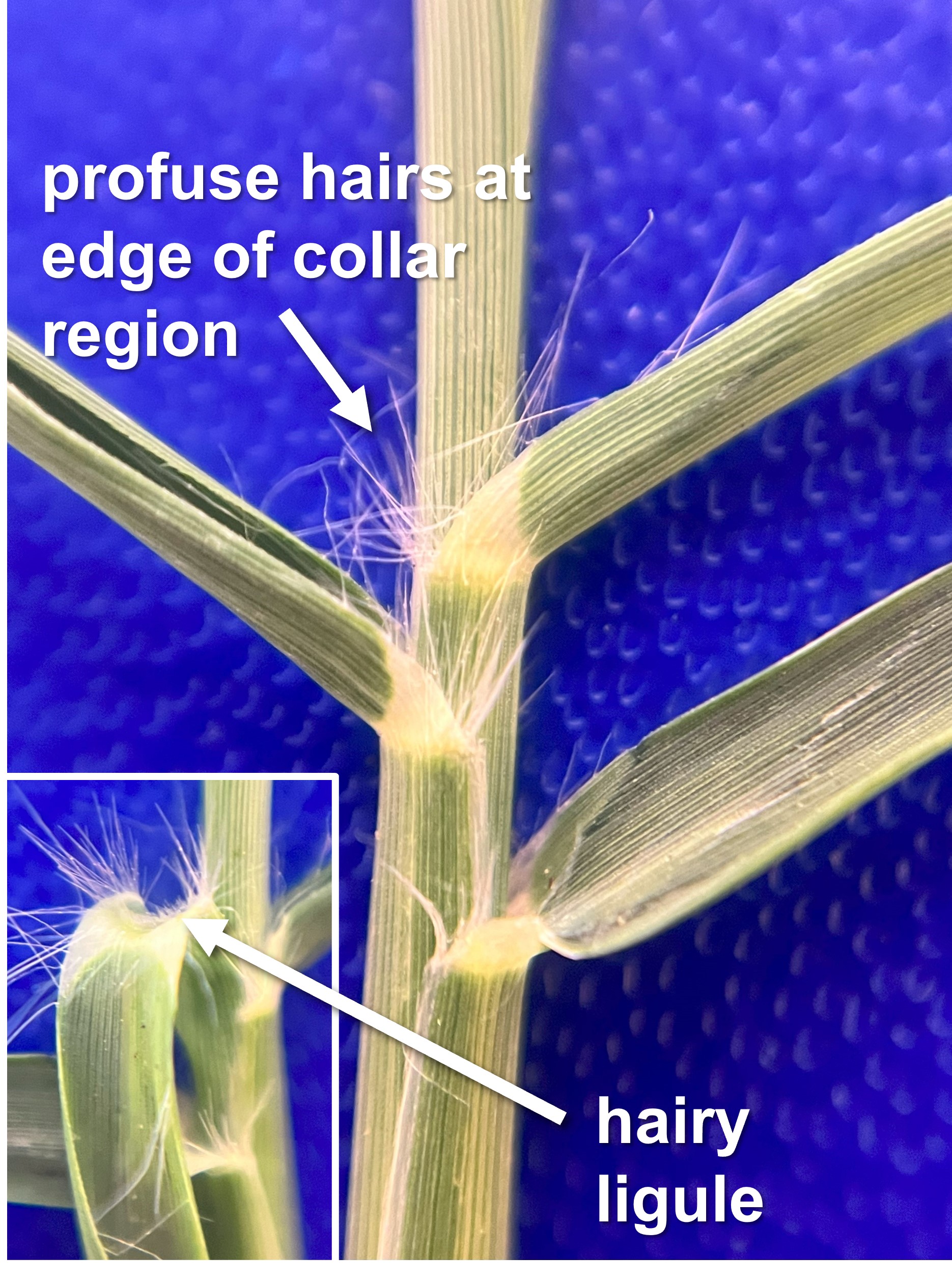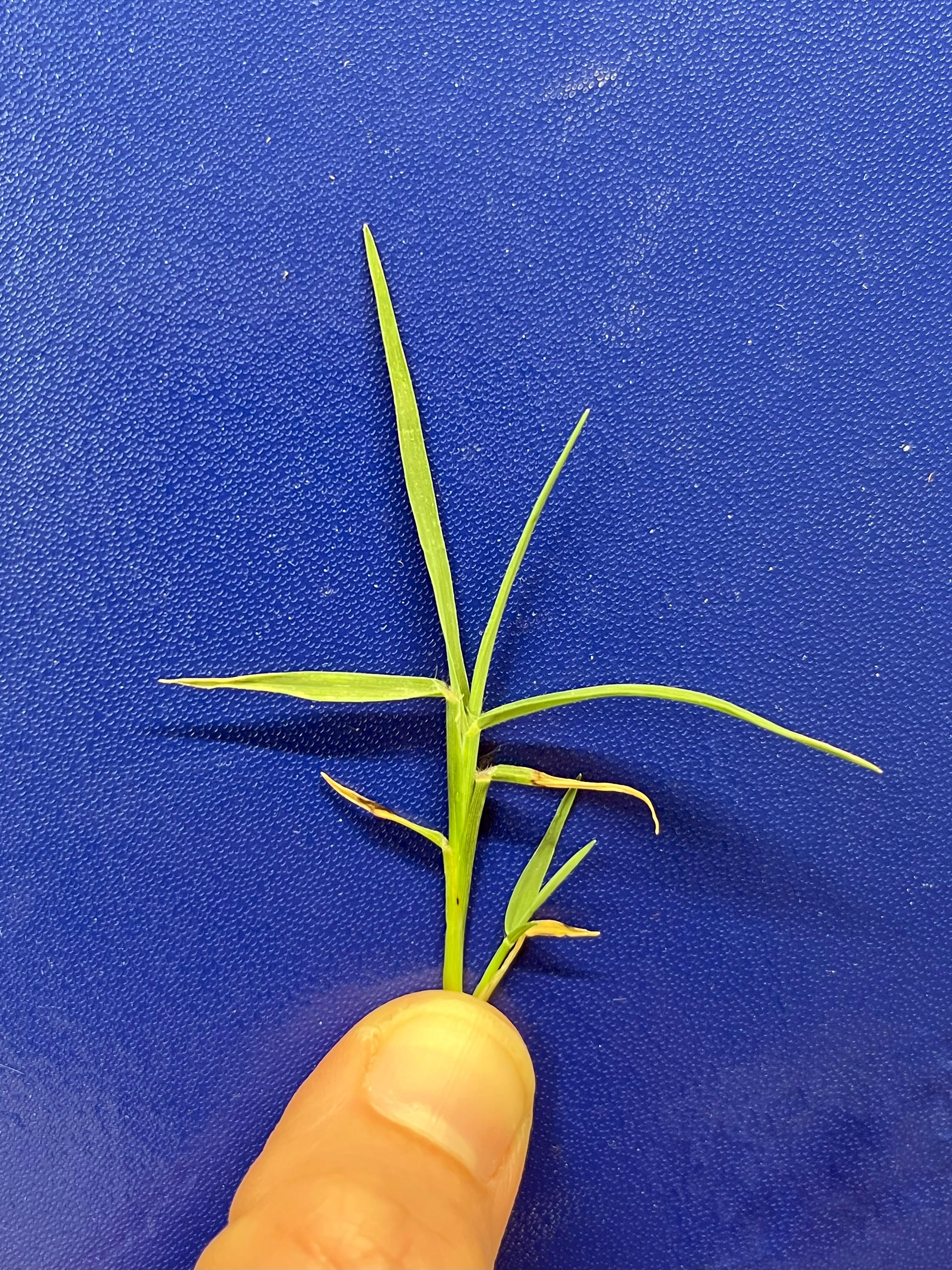Pain in the grass: Bermudagrass
Tackling bermudagrass in a residential lawn can be daunting. Learn more about the biology and management strategies.

Bermudagrass (Cynodon dactylon) is a perennial warm-season grass that was introduced to the state of Michigan. During the colder months, this grass goes dormant and turns brown. This combined with its slight blue to gray hue in the warm months and thick creeping stems (i.e., stolons, Photo 2) makes it stand out from our typical cool-season lawn species (i.e., Kentucky bluegrass, ryegrasses and fescues).
To confirm your weedy grass is indeed bermudagrass, peel back the leaf from the stem and look for a line of hairs at the base (i.e., hairy ligule) with shaggier hairs at the outer edges (Photo 3). Stolons will be thick and leaves will be variable in length from 2 to 6 inches, depending on the growing conditions (Photo 4). Seedhead production is rare under most mown conditions, but when allowed to grow, spikes that appear like fingers form, similar to crabgrasses but shorter (about 1 inch long, Photo 5).


Managing grassy weeds in a desired stand of grass presents several challenges due to similarities in biology, and this plant is no exception. Bermudagrass possesses the trifecta of reproductive tactics, using seed, stolons and rhizomes (underground stems) to spread.
Cultural practices such as irrigation, fertilizer use and increased mowing heights are not sufficient to control bermudagrass. Manual removal of bermudagrass may be possible for small infestations, however care is needed to completely excavate the area to ensure no rhizomes remain. According to research from Horowitz 1972, rhizomes can reach depths of approximately 18 inches, depending on the soil type. Many times, this is not feasible and herbicide treatments should be considered.
There are herbicides that can selectively suppress bermudagrass (i.e., keeping desired species), but none that can selectively eliminate it. Due to the intensity of the suppression applications, possible issues with product procurement and application, and the inability to achieve complete control, renovating the area is often recommended (see more on suppression at the end of this article). The systemic herbicide active ingredient glyphosate (e.g., Roundup Super Concentrate Weed and Grass Killer, among others) can be used to kill the area where the infestation occurs, though multiple treatments will likely be needed. This will cause harm to your desired grass and require reseeding after control is achieved.
Similar to other articles in the Pain in the Grass series from Michigan State University Extension, here are some considerations on glyphosate use tweaked slightly for this particular species.
When using products containing glyphosate, there are a few important points to consider. First, as with any pesticide, remember to read and follow all labeled instructions. Second, glyphosate is a broad-spectrum herbicide, meaning it will injure or kill other plants contacted during application, so care is needed to avoid green plant material, exposed roots and injured bark of desired plants. Third, glyphosate is relatively safe in the environment when used as labeled. It adsorbs strongly to soil in most cases (i.e., clay and organic matter), allowing replanting shortly after application; meaning no carryover issues are expected.
Fourth, glyphosate does not offer instant gratification. When used alone, it can take up to 14 days to show full activity under ideal growing conditions. Retreatment of the area will likely be needed depending on the degree of infestation (treating at intervals of three to four weeks). Glyphosate is most effective for perennial control (like bermudagrass) in the fall prior to frost, but can be applied anytime the plants are actively growing (temperatures consistently above 50 degrees Fahrenheit). Do not mow immediately before or after the herbicide application; the goal is to maximize the leaf area for herbicide absorption and minimize stress (counter intuitive).
Finally, be sure that the product chosen has only the active ingredient glyphosate. Products with additional active ingredients may cause antagonism (e.g., pelargonic acid and diquat), have other unwanted effects, and/or may delay the planting of other plants in the coming season(s).
After control has been achieved and the area is replanted, continue to keep an eye out for any new bermudagrass appearing and spot treat as necessary. Visit MSU Extension’s Home Lawns website for more information on lawn care from the MSU turfgrass team.
Regarding bermudagrass suppression, the Turfgrass Weed Control Guide for Professionals currently has a couple recommendations requiring multiple treatments applied at specific times. Consulting a reputable, local lawn care service would be advised. Note, only one of these tactics would be utilized, not both.
- Option 1
- Mix Acclaim Extra (active ingredient fenoxyprop) at a 28 oz/A rate with Turflon Ester Ultra or Triclopyr4 (a.i. triclopyr) at 1 qt/A.
- Apply every 28-35 days in late-spring and again in early-fall.
- Option 2
- Mix Pylex (a.i. topramezone) at 1.33 fl oz/A + Turflon Ester Ultra or Triclopyr4 (a.i. triclopyr) at 1 qt/A + methylated seed oil (MSO) 0.5-1.0% volume/volume.
- Apply every 21-28 days (maximum three applications) starting in late summer (i.e late-August to early-September).
To learn more about other weedy grasses that occur in lawns, visit the other articles in the Pain in the Grass series.
If you need help identifying your weedy grass, consider reaching out to your local MSU Extension office or contacting MSU Plant & Pest Diagnostics.
Thanks to Angie Tenney for reviewing this article.



 Print
Print Email
Email



